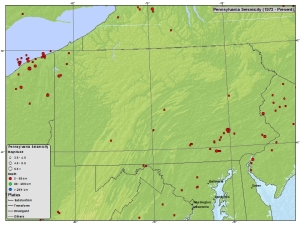Drop, cover and hold on: Pennsylvanians participate in worldwide earthquake drill as quake concerns rise

By Rachel Martin | Watchdog.org
PITTSBURGH — Thousands of Pennsylvanians were expected to DROP! COVER! and HOLD ON! Thursday morning as part of a global earthquake drill.
Some 375,000 Pennsylvanians will take part in the drill, along with 20 million other people across the globe. Whether spurred by increased concerns about fracking-related earthquakes or simply memories of quakes that have shaken the state, preparedness is on the rise in the Keystone State.
Cory Angell, spokesman for the Pennsylvania Emergency Management Agency, said his office is mostly doing social-media and other outreach.
“I don’t know how many people are going to climb under their desks — but I’m going to,” he said.
The ShakeOut began in Southern California in 2008 and now has expanded worldwide.
The material for the drill includes a video or an audio file, as well as extensive directions for teachers and others.
The bulk of Pennsylvania’s participants are school kids — 362,000 of them.
Chris Tantlinger, hazard mitigation officer for Westmoreland County, in southwestern Pennsylvania, says his office isn’t so much going to be “dropping down and getting under tables for this” – because “these are seasoned professionals in emergency management.”
Their work Thursday will mostly be communications-based, like doing “radio roll-call” with all of the 65 municipalities in his county and testing the “all-call” paging system.
On the county’s webpage for the event, it notes 2011’s 5.8 magnitude earthquake centered near Richmond, Va., “which was felt throughout our region.”
Tantlinger said the quake caused minor structural damage, mainly in historical buildings, and it may have been responsible for some utility-line breaks.
According to Philadelphia reporting at the time, that same earthquake “rocked communities from Georgia to Canada,” including the City of Brotherly Love. It was reported to be “the most powerful temblor on the East Coast in 114 years and the third-strongest on record.”
Recent research on fracking yields somewhat strange results.
On one hand, research seems to show that it’s not so much the immediate process of fracking that causes “felt earthquakes,” but instead the related process of using injection wells to dispose of water used in fracking. See here, here and here.
But those earthquakes can be severe, even if found only in a minority of sites. One study concluded that an injection well in Youngstown, Ohio, was linked to the 109 earthquakes in the year after the well came online.
The strongest of those quakes registered 4.0 on New Year’s Eve 2011. That earthquake was felt in Ohio, Pennsylvania and Canada. That injection well is now shuttered.
Earthquakes below 2.5 to 3.0 aren’t generally felt, and damage is more likely from those 4.0 and higher.
SOME SHAKIN’ GOIN’ ON: This United States Geological Survey map shows seismic activity in the Keystone State.
This spring, Ohio’s Department of Natural Resources announced “stronger permit conditions for drilling near faults or areas of past seismic activity.”
This came after several earthquakes near one drilling site in Mahoning County, in northeast Ohio. With the announcement, ODNR said a “probable connection to hydraulic fracturing near a previously unknown microfault.”
This summer, the Pennsylvania Department of Environmental Protection began mulling similar provisions but is taking more time to gather data.
Angell wouldn’t say whether there’s more concern about earthquakes from a perception about increased seismic activity.
“Our citizens seem more interested in being prepared for an earthquake,” he said.
Perhaps it’s just an increased awareness of earthquakes. Angell noted the 2011 earthquake as making him more mindful that it’s “certainly a very real possibility.”
In the past year, Pennsylvania has had no earthquakes stronger than 2.5 with epicenters in the state, though two have been a mere five miles across its western border with Ohio. For contrast, on Tuesday and Wednesday, Oklahoma had nine, ranging from 2.5 to 3.4.
So while only 41,000 Oklahomans are participating in the drill, Oklahomans are presumably pros.
The US Geological Survey has an interactive map of earthquakes here, though a more easily searchable one is here.







